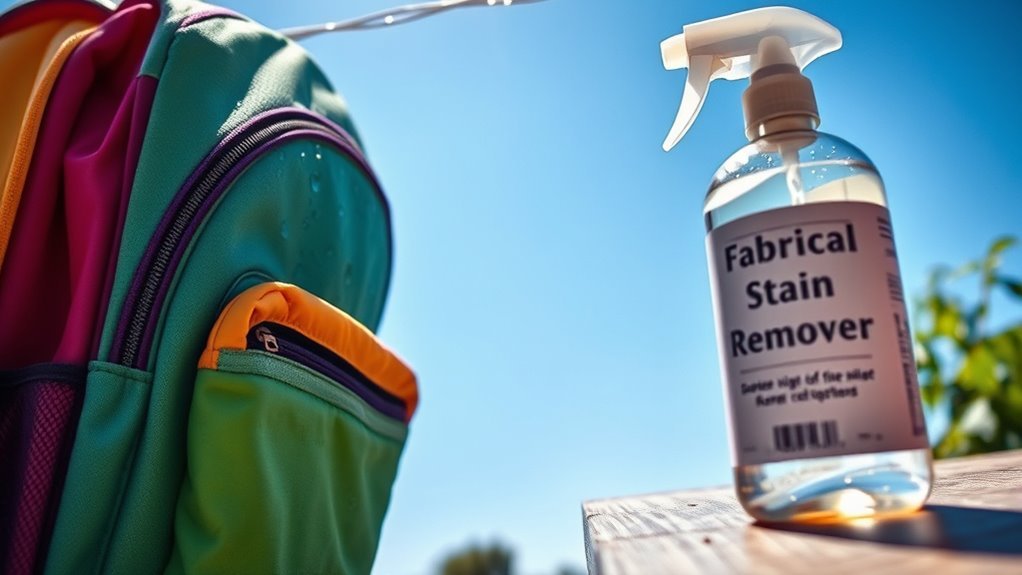Removing School Bag Stains From Washer
To remove school bag stains in your washer, first identify the stain type—ink, food, or oil—to choose an appropriate pre-treatment like liquid detergent for grease or enzymatic remover for protein stains. Use cold or warm water on a gentle cycle to protect fabric and hardware, and avoid the dryer to prevent damage. Open compartments for thorough air drying. Proper stain identification and washer settings maximize cleaning efficiency and bag longevity; further steps guarantee effective stain elimination and maintenance.
Identifying Common Types of School Bag Stains

How do you pinpoint the exact type of stain on your school bag? Begin by examining the stain’s color, texture, and location. Ink stains typically appear as dark, sharp marks and often originate from pens or markers inside your bag. They tend to soak into fabric fibers, making identification straightforward. Food spills, on the other hand, vary widely but usually present as sticky or greasy patches with irregular edges. They often carry residual odors or visible particles. Understanding these characteristics helps you approach stain removal with precision, ensuring you don’t waste time on ineffective treatments. Recognizing the distinction between ink stains and food spills empowers you to take control, maintaining your bag’s appearance without compromising your freedom to carry essentials confidently.
Pre-Treatment Methods Before Washing
Before washing your school bag, applying the right pre-treatment is essential to break down stains effectively. Start by identifying the stain type to select appropriate pre treatment techniques. For oil-based stains, gently blot excess residue, then apply a small amount of liquid detergent directly onto the stain, allowing it to penetrate for 10-15 minutes. For protein stains like food, soak the affected area in cold water combined with an enzymatic stain remover to loosen proteins. Avoid hot water initially, as it can set stains. Use a soft brush to agitate the solution into the fabric, enhancing stain removal. Always test pre-treatment agents on a hidden area first to prevent fabric damage. These precise steps optimize stain breakdown, ensuring your bag is thoroughly cleaned while preserving its integrity.
Choosing the Right Detergent for Stain Removal

When selecting a detergent, you need to evaluate the type of stains present on the school bag. Different detergents are formulated to target specific stain categories, such as grease, ink, or dirt. Understanding these distinctions will help you choose the most effective product for best stain removal.
Detergent Types Overview
Although many detergents claim to remove stains effectively, choosing the right type depends on the fabric of the school bag and the nature of the stain. Liquid detergents dissolve quickly and are ideal for recent, greasy stains; they penetrate fabric fibers efficiently without leaving residue. Powder detergents, on the other hand, are effective on ground-in dirt and mud due to their alkaline properties but may not dissolve fully in cold water, potentially leaving deposits on synthetic fabrics. When selecting a detergent, consider the bag’s material—delicate fabrics benefit from gentle liquid formulations, while robust fabrics can tolerate powder detergents’ stronger cleaning agents. Your choice influences stain removal efficacy and fabric longevity, so assess detergent solubility, stain type, and fabric care instructions for best results.
Stain-Specific Detergents
Anyone aiming to remove specific stains from a school bag should select detergents formulated for those particular stain types. Different stains—such as grease, ink, or food—respond best to targeted chemical agents within specialized detergents. For example, enzymatic detergents excel in breaking down protein-based stains, enhancing detergent effectiveness. When choosing a detergent, consider the stain’s composition and match it with appropriate active ingredients like surfactants, enzymes, or solvents. Using a generic detergent may reduce stain removal efficiency, prolonging stain presence. Always test the detergent on a small, inconspicuous area of the bag to verify material compatibility. By selecting stain-specific detergents, you optimize stain removal processes, maintain fabric integrity, and gain the freedom to keep your school bag clean without unnecessary damage or repeated washing cycles.
Optimal Washer Settings for Cleaning School Bags
You’ll want to set your washer to a cold or warm water temperature to protect the bag’s material while effectively loosening stains. Select a gentle or delicate cycle to prevent damage to zippers and straps. Use a detergent designed for tough stains that’s compatible with your chosen settings for ideal cleaning performance.
Best Water Temperature
When selecting the best water temperature for washing school bags, you should consider the material and type of stains present. Typically, cold water (below 80°F) is suitable for delicate fabrics or synthetic materials, reducing the risk of damage or color bleeding. For effective stain removal of organic stains like food or mud, warm water (between 90°F and 110°F) enhances detergent activation without compromising fabric integrity. Hot water (above 120°F) can improve removal of greasy or oily stains but may shrink or weaken certain textiles. To maximize stain removal while preserving your bag’s structure, choose the lowest temperature that effectively targets the stain type. This methodical approach balances cleaning efficiency and fabric care, granting you freedom from worry about damaging your school bag during washing.
Ideal Wash Cycle
Selecting the ideal wash cycle is essential for effectively cleaning school bags without causing damage. You need to match the wash cycle duration and settings to the bag’s fabric type to maintain its integrity and cleanliness. For most school bags, a gentle cycle with a shorter wash cycle duration prevents wear while removing stains effectively. Consider these key points:
- Use a delicate or gentle cycle for nylon or polyester bags to avoid fabric weakening.
- Opt for a medium wash cycle duration for canvas bags to balance stain removal and fabric care.
- Avoid heavy-duty cycles on bags with leather accents or embellishments to prevent damage.
Detergent Recommendations
Three factors determine the best detergent choice for washing school bags: fabric type, stain severity, and washer settings. You’ll want to select a detergent compatible with synthetic fabrics like nylon or polyester to avoid damage. For heavy stains, opt for a formula with stronger enzymes, but make sure it suits your washer’s temperature and cycle to maximize effectiveness. Eco friendly options are highly recommended; they minimize environmental impact without sacrificing cleaning power. Additionally, consider fragrance choices carefully—if you prefer a neutral scent to avoid irritation or a revitalizing aroma, select accordingly. Align detergent concentration with the load size and cycle intensity to prevent residue buildup. By tailoring detergent selection to these criteria, you maintain your bag’s integrity while achieving excellent stain removal and preserving freedom from harsh chemicals.
Effective Homemade Solutions for Tough Stains
Although tough stains on school bags can seem stubborn, you can tackle them effectively using simple homemade solutions. Relying on natural stain removers and DIY cleaning solutions not only preserves the fabric but empowers you with freedom from harsh chemicals. Start by preparing a paste of baking soda and water for grease stains—apply, let sit, then scrub gently. For ink or marker stains, dab with a mixture of rubbing alcohol and water, being careful to test fabric compatibility first. Ultimately, use white vinegar combined with dish soap to break down organic stains like food or mud. These methods offer a precise, methodical approach to stain removal, allowing you to maintain your school bags efficiently without commercial products.
Tips for Drying and Maintaining School Bags After Washing

Once you’ve treated and washed your school bag, proper drying and maintenance become the next steps to confirm its longevity and appearance. Start by using appropriate drying techniques: air drying is ideal, so hang the bag in a well-ventilated area away from direct sunlight to prevent color fading and fabric damage. Avoid using a dryer or heat sources as they can warp materials or degrade zippers. Make sure all compartments are open to allow thorough drying inside. For ongoing bag maintenance, regularly inspect seams, zippers, and straps for wear and promptly address minor repairs to prevent further damage. Store your bag in a dry, cool place to avoid mold and odors. Following these precise steps will keep your bag functional and fresh, supporting your freedom to carry essentials without worry.
Preventive Measures to Avoid Future Stains
To minimize the risk of future stains on your school bag, you should implement targeted preventive measures that address common sources of dirt and spills. Effective stain prevention begins with consistent bag maintenance and conscious usage habits. Here are three practical steps to incorporate:
Minimize future stains by adopting consistent maintenance and mindful habits to keep your school bag clean and protected.
- Use protective sprays designed for fabric to create a water and stain-resistant barrier.
- Designate a specific clean area for placing your bag, avoiding floors or surfaces prone to dirt.
- Regularly clean and inspect your bag for early signs of wear or contamination, intervening promptly.
Adopting these measures guarantees your bag remains cleaner longer, reducing the frequency of intensive cleaning cycles. This methodical approach to stain prevention maximizes your freedom to use your bag confidently without constant concern over damage or unsightly marks.
Frequently Asked Questions
Can Leather School Bags Be Washed in a Washing Machine?
You shouldn’t wash leather school bags in a washing machine since it damages the material. For proper leather care, use gentle washing tips: spot-clean with a damp cloth and mild soap, then air-dry away from heat. Leather requires careful handling, so avoid soaking or machine agitation. This method preserves your bag’s texture and flexibility, giving you the freedom to maintain its look without risking harm from automated washing processes.
How Often Should School Bags Be Washed?
Think of your school bag as a steadfast companion on your daily journey, needing care to stay reliable. Following frequency guidelines, you should wash it every 4 to 6 weeks, depending on usage and dirt accumulation. Maintenance tips include spot cleaning between washes and ensuring it’s fully dry before use. This methodical approach frees you from unexpected odors or wear, keeping your bag functional and fresh, ready to support your freedom to explore.
Are There Any Health Risks From Washing Contaminated School Bags?
You should be aware that health risks can arise from washing contaminated school bags due to contamination sources like bacteria, viruses, and allergens embedded in fabric. If these aren’t properly removed, they may spread to your washer or other laundry. To minimize risk, use hot water and appropriate detergents, and sanitize the washer afterward. Taking these steps guarantees you maintain hygiene without restricting your freedom to clean effectively.
Can Washing School Bags Cause Color Fading?
Yes, washing school bags can cause color fading, especially if you don’t consider fabric types and washing methods. Synthetic fabrics often have better color retention than natural fibers, but harsh detergents or hot water can still degrade dyes. To maintain color retention, you should use cold water, gentle cycles, and mild detergents. Avoid bleach or prolonged sun drying, as they accelerate fading. Being methodical with these factors helps preserve your bag’s look and extends its life.
Is It Safe to Wash School Bags With Electronics Inside?
Imagine your electronics as delicate snowflakes caught in a storm—washing electronics inside a bag is risky and can cause irreversible damage. For proper bag care, always remove all gadgets before washing to prevent short circuits or corrosion. Use a gentle cycle with cold water and mild detergent for the fabric alone. Protect your freedom by ensuring your devices remain dry and intact; never gamble with wet electronics inside the washer.






